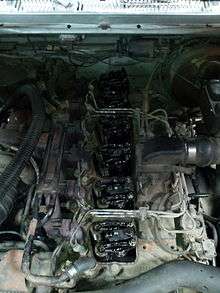Valvetrain



A valve train or valvetrain is a mechanical system that controls operation of the valves in an internal combustion engine,[1] in which a sequence of components transmits motion throughout the assembly. A traditional reciprocating internal combustion engine uses valves to control air and fuel flow into and out of the cylinders, facilitating combustion.[2]
Layout
The valve train consists of valves, rocker arms, pushrods, lifters, and camshaft(s).[3] Valve train opening/closing and duration, as well as the geometry of the valve train, controls the amount of air and fuel entering the combustion chamber at any given point in time.[4] Timing for open/close/duration is controlled by the camshaft that is synchronized to the crankshaft by a chain, belt, or gear.
Valve trains are built in several configurations, each of which varies slightly in layout but still performs the task of opening and closing the valves at the time necessary for proper operation of the engine. These layouts are differentiated by the location of the camshaft within the engine:
- Overhead camshaft
- The camshaft (or camshafts, depending on the design employed) is located above the valves within the cylinder head, and operates either indirectly or directly on the valves.
- Camless
- This layout uses no camshafts at all. Technologies such as solenoids are used to individually actuate the valves.
Parts
The valve train is the mechanical system responsible for operation of the valves. Valves are usually of the poppet type, although many others have been developed such as sleeve, slide, and rotary valves.
Poppet valves typically require small coil springs, appropriately named valve springs, to keep them closed when not actuated by the camshaft. They are attached to the valve stem ends, seating within spring retainers. Other mechanisms can be used in place of valve springs to keep the valves closed: Formula 1 engines employ pneumatic valve springs in which pneumatic pressure closes the valves, while motorcycle manufacturer Ducati uses desmodromic valve drive which mechanically close the valves.
Depending on the design used, the valves are actuated directly by a rocker arm, finger, or bucket tappet. Overhead camshaft engines use fingers or bucket tappets, upon which the cam lobes contact, while pushrod engines use rocker arms. Rocker arms are actuated by a pushrod, and pivot on a shaft or individual ball studs in order to actuate the valves.
Pushrods are long, slender metal rods seated within the engine block. At the bottom ends the pushrods are fitted with lifters, either solid or hydraulic, upon which the camshaft, located within the cylinder block, makes contact. The camshaft pushes on the lifter, which pushes on the pushrod, which pushes on the rocker arm, which rotates and pushes down on the valve.
Camshafts must actuate the valves at the appropriate time in the combustion cycle. In order to accomplish this the camshaft is linked to and kept in synchronisation with the crankshaft (the main shaft upon which the pistons act) through the use of a metal chain, rubber belt, or geartrain. Because these mechanisms are essential to the proper timing of valve actuation they are named timing chains, timing belts, and timing gears, respectively.
Typical normal-service engine valve-train components may be too lightweight for operating at high revolutions per minute (RPM), leading to valve float.[5] This occurs when the action of the valve no longer completely opens or closes, such as when the valve spring force is insufficient to close the valve (it does not fully rest on its seat even though the cam would allow the valve to close) causing a loss of control of the valvetrain, as well as a drop in power output.[6] Valve float will damage the valvetrain over time, and could cause the valve to be damaged as it is still partially open while the piston comes to the top of its stroke.[7] Upgrading to high pressure valve springs could allow higher valvetrain speeds, but this would also overload the valvetrain components and cause excessive and costly wear.[8]
High-output and engines used in competition feature camshafts and valvetrain components that are designed to withstand higher RPM ranges.[9] These changes also include additional modifications such as larger-sized valves combined with freer breathing intake and exhaust ports to improve air flow.[10] Automakers offer factory-approved performance parts to increase engine output, and numerous aftermarket parts vendors specialize in valvetrain modifications for various engine applications.[11][12]
See also
References
- ↑ Brain, Marshall (5 April 2000). "How Car Engines Work". HowStuffWorks. Retrieved 29 January 2014.
- ↑ "Sci-Tech Dictionary: "valve train"". Answers.com. Retrieved 29 January 2014.
- ↑ "The Valve Train". AutoEducation. Retrieved 29 January 2014.
- ↑ Scraba, Wayne (October 2000). "Camshaft Tips & Definitions". Hot Rod. Retrieved 29 January 2014.
- ↑ Cranswick, Marc (2011). The Cars of American Motors: An Illustrated History. McFarland. p. 80. ISBN 9780786446728. Retrieved 29 January 2014.
- ↑ Vizard, David (1992). How to Build and Modify Chevrolet Small-Block V-8 Camshafts and Valves. Motorbooks International. p. 114. ISBN 9780879385958. Retrieved 29 January 2014.
- ↑ Forst, Sarah (2008). How to build performance Nissan sport compacts, 1991-2006. HP Books. p. 29. ISBN 9781557885418. Retrieved 29 January 2014.
- ↑ Ellinger, Herbert E. (1974). Automotive engines. Prentice-Hall. p. 171. ISBN 9780130554260. Retrieved 29 January 2014.
- ↑ Tom, David (2013). The Cars of Trans-Am Racing: 1966-1973. CarTech. p. 32. ISBN 9781613250518. Retrieved 29 January 2014.
- ↑ Sessler, Peter C. (2010). "24: American Motors Corporation V-8s, 1958-1991". Ultimate American V-8 Engine Data Book (Second ed.). MBI Publishing. p. 229. ISBN 9780760336816. Retrieved 29 January 2014.
- ↑ Fletcher, Mark; Truesdell, Richard (2012). Hurst Equipped: More Than 50 Years of High Performance. CarTech. p. 63. ISBN 9781934709313. Retrieved 29 January 2014.
- ↑ Shepard, Larry (1989). How to Hot Rod Small-block Mopar Engines. HPBooks. pp. 74–88. ISBN 9780895864796. Retrieved 29 January 2014.